| Report Type | Full |
| Peak(s) |
Kilimanjaro - 19340 |
| Date Posted | 02/16/2009 |
| Date Climbed | 02/01/2009 |
| Author | Trail Doc |
| Kilimanjaro- Lemosho Route |
|---|
|
My father, Albian, my wife, The Scrubbing Bubble, and I did the Lemosho route of Kilimanjaro Jan 24- Feb 2. We went with the guide service Tusker Trail www.tusker.com, which is a first class operation with a first class price tag. We arrived in Moshi after flying NWA and KLM from JFK through Amesterdam. Our guide service picked us up at the airport and accommodated us at the Keys Hotel in Moshi, which they claim is among the more comfortable hotels in Moshi. I found it rustic, with small rooms, wooden cots with foam mattresses rather than actual beds, and food that were marginal at best. However, you don't want a hotel that's too comfortable lest your accommodations on the mountain seem too austere. We spent a full day at the hotel, getting over our jet lag, meeting with our guides and organizing our gear. Our guides were quite professional, spoke excellent English, and gave us a good overview of what to expect on the mountain. They also introduced us to some of the emergency gear they carry, including a Gamow bag, and their evacuation procedures, which were self sufficient and don't rely on the park resources. As a side note, Tusker told that on average there is a client fatality every 12 days on Kilimanjaro, so emergency capability is well spent. We departed Keys the next morning for the Londrossi gate, which took about 5 hours to drive. We stopped twice in villages along the way to allow our crew to pick up some gear. Apparently, fair skinned westerners are a rare occurrence here. While we were stopped the three of us generated quite a bit of interest among the children who asked for money and food, but mostly from adults who stared at us as they walked by. After checking in at the gate, we drove another hour over some pretty rough 4WD roads to the trailhead. The roads would not have been so bad if it were not for the rain that fell the evening before. We started in the forest at about 7300 ft and hiked about three miles to Big Tree camp at about 9000 ft. The hiking was relatively rough with washed out trails that often went straight up a steep hillside. There were many exposed roots that look as if they were designed to break your ankle. 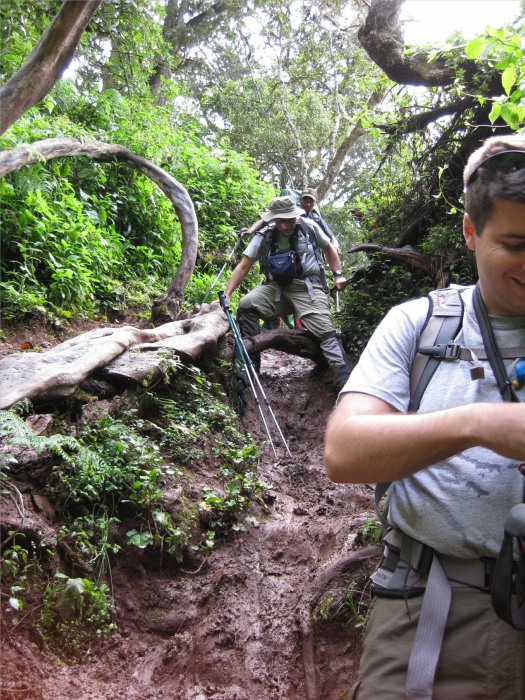 The Scrubbing Bubble had an encounter with Safari Ants here she won't soon forget. Look out for these guys with big jaws that hold pretty tightly. I never got bit, but I could feel them crawling on me for the rest of the day. We also saw a troop of Colobus monkeys and a Blue Monkey as we ascended the forest. Through the night we heard them calling to each other. 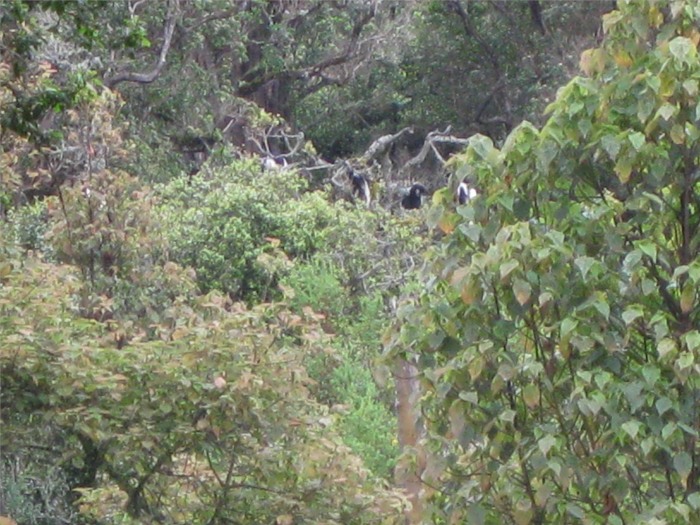 We got to camp at about 5pm, which would become typical over the next few days. Had dinner of soup, fried fish, potatoes and fruit for dessert. This would also become typical. Each breakfast would consist of a hot cereal (oatmeal, millet or cream of wheat) and omelets with sausage. Each lunch and dinner we were served hot soup, as well as an entrée like French toast, sandwiches, corn fritters. We ate a lot of fried food. Although the food was good, I had trouble keeping my appetite at altitude. We ate because we knew we needed to, not because we were hungry. It became a chore. I was surprised at how cold it became that night at such a low elevation. I even broke out my synthetic parka, which I had not planned to do until much higher on the mountain. It did not rain or frost that night, but it was the last night when neither of those things happened. January is supposed to be the driest month, but I gather the wet season comes on fast, and we were there for the beginning of it. The next morning we packed up and hiked the better part of the day to Shira I Camp. We ascended out of the forest into the heather zone, which made transition abruptly, in the space of about 30 yards. By 1pm we caught up with our crew who had set up the dining tent and had a hot lunch waiting for us. They had also set up the commode tent, and I recall thinking that was unnecessary (foreshadow). Shira camp is about at 11,500 ft and was pretty exposed to wind, so was rather cold for the elevation. We awoke the next morning to frost, which quickly melted as soon as the sun came over the summit of Kili to our east. When we arrived in camp the summit was clouded over, but when we woke up we were treated to our first clear view of the summit since the hotel. 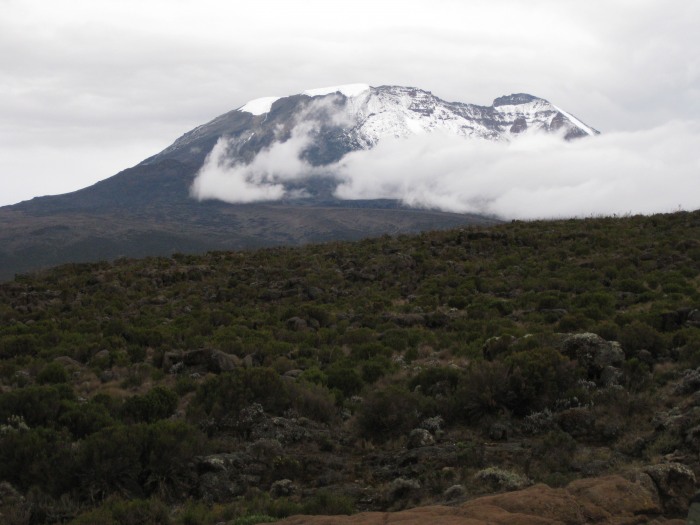 We hiked across the Shira Plateau, which is a large flat area that is actually the oldest of the three volcanos that make up Kilimanjaro. We had lunch at Fischer camp, which is named for Scott Fischer, the ill-fated Mountain Madness guide who died on Everest in May of 1995. Our next camp was Moir Camp at 13,500 ft. We were the only crew there that night. I had been dragging around a cold since the hotel and by this point it had significantly improved. However at 4am I awoke to pretty bad stomach cramps and thunderous diarrhea. Over the next 24 hours I let it run its course to exorcise whatever evil spirits had taken residence in my bowels. That made for an interesting hike up to the Lava Tower that day. When we caught up with the crew for lunch at 15,000 ft I was very pleased to see they had set up the commode. Our itinerary had us planned to lay over at the Lava Tower for two nights, but because I was feeling so poorly, we opted to descend to Barranco camp. Even though my problems were not AMS, lower elevation would not hurt. This came with the added advantage of starting the next day by climbing the Barranco wall. The next morning after 24 hours, several doses of immodium and Cipro, as well as several liters of oral rehydration salts later, I was ready to press. The Barranco Wall is a short bit of class 2 that took us about 2 hours do to. We ascended with about 5 other crews that morning, which made for quite a traffic jam on the way up. No point in getting irritated about that. If wilderness experience is what you're after, Kili is not your mountain. 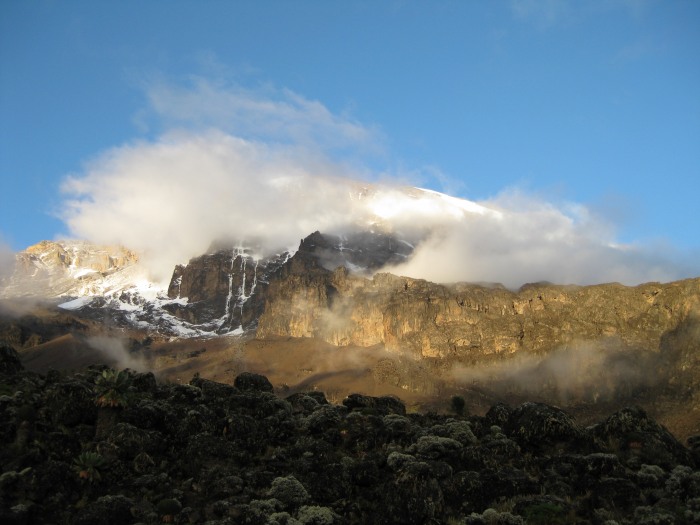 The rest of the day to Karanga camp was pretty mild. The hike was gentle once we reached the top of the wall, except for the last half-mile which dropped about 300 feet into a pretty steep ravine, and back out again. It seemed as if we did a lot of uphill that day, but in the end we finished at about 13,200, the same elevation we started at. We had a hot lunch in camp this day since we arrived rather early. We did talk some about doing a short hike after lunch, but sloth got the better of us, and I enjoyed a fine afternoon nap. 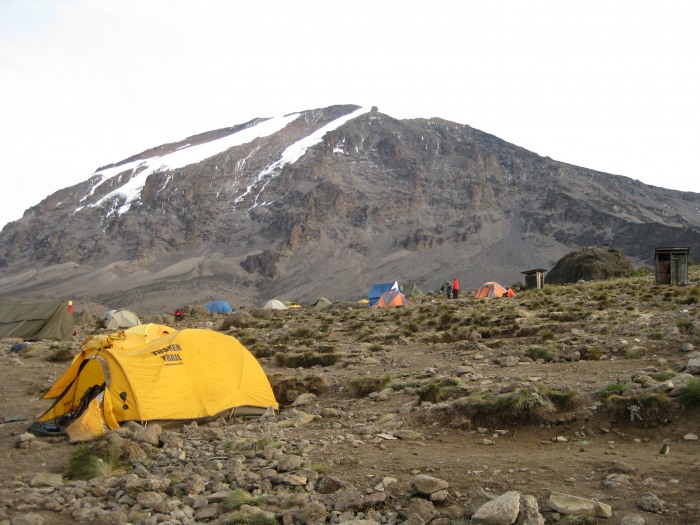 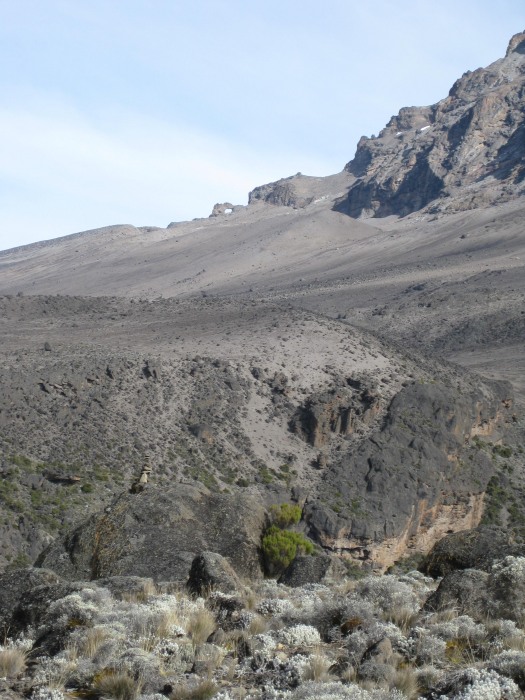 The next day brought us to Barafu camp at 15,000 ft, which was to be our high camp prior to summitting. 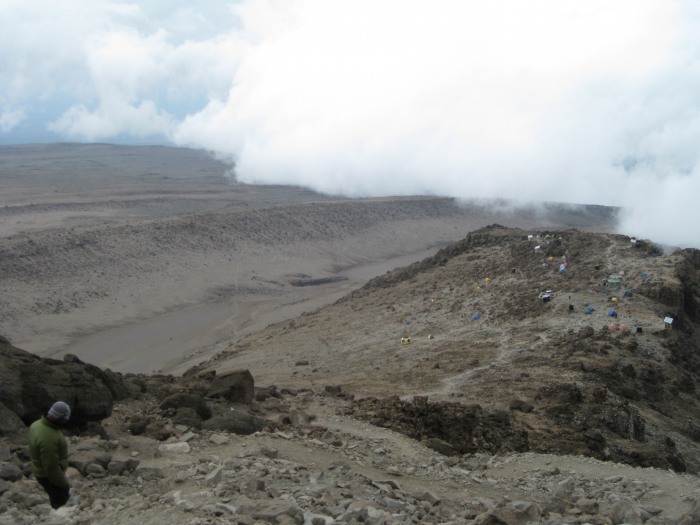 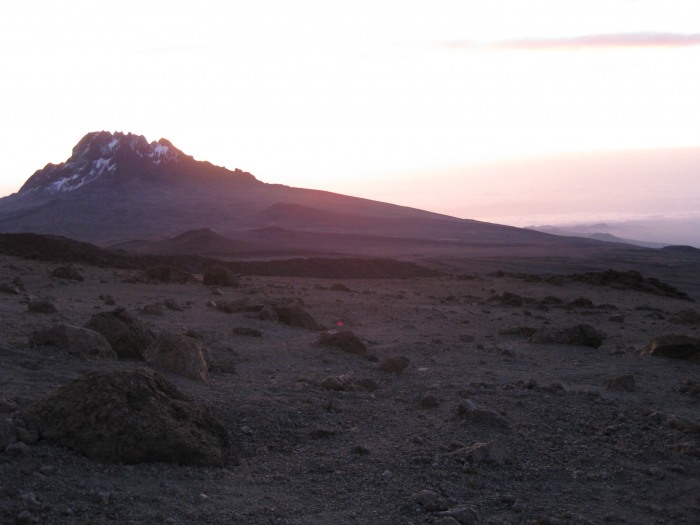 Our itinerary originally had us staying at crater camp at 18,000 ft. However, it seemed unnecessary to do this and get a poor night sleep due to the altitude, so we did our summit push from Barafu and back. Many crews will start at Barafu at midnight, summit at dawn and descend to Millennium camp, which makes for a very long day. We started at about 5:30 am, and it took about 6 hours to get to Stella point on the crater rim. Just below the rim, Albian and I felt the affects of AMS coming on, so our guide broke out the oxygen and gave us each a dose of dexamethasone. From there it was an easy hour to Kibo peak (the youngest of the three volcanos, and what is typically considered the summit) and we made it there about 12:30 local time on Super Bowl Sunday. 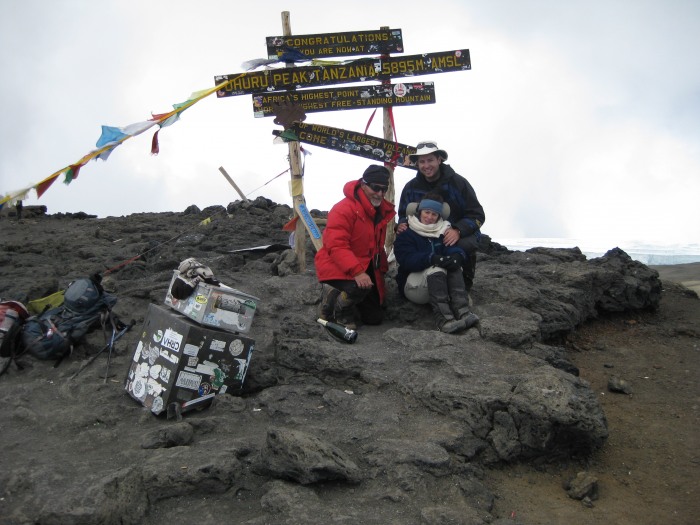 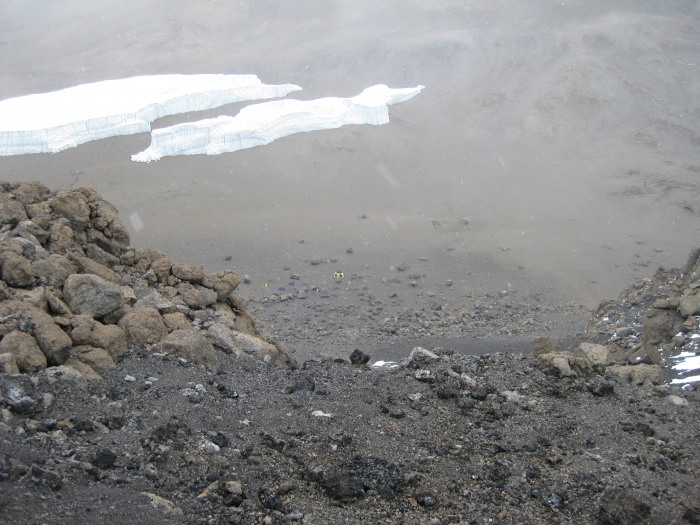 After the requisite photos at the summit, we descended into the crater and had our packed lunch at crater camp. I saw a crew ascending from the western breach, which I had thought was closed but my guide said otherwise. We took a number of photos of the glacier at in the crater and opted against the hour's hike up to the Ash Pit because clouds were blowing in and we figured all we'd get would be a good look at fog. Once we made it back to Stella point, it was about 90 minutes down through light snow to Barafu camp. The next day original plan was to descend to Millennium or Mewka camp for the night, but once we reached the low camp for lunch, we figured it was worth pressing on to the Mewka gate. Once you make the summit, nothing sounds quite as good as a shower. The whole trek was planned for 10 days, but because of the changes we made, we came off the mountain 2 days early. Fortunately, Tusker pays the crew for the trek, and not by the day. We were happy to give our crew two days off with pay since they had done such a great job for us. After a day at the hotel, where the accommodations and food were not as good as on the mountain, shower not withstanding, we departed for a 6 day Safari at Ngorongoro and the Serengeti. That in itself was quite a trip, and another report altogether. Notes on: Water: Many of the camps we stayed at were dry camps, and the crew ported water several miles for us. I see this as the biggest hurdle to a solo or minimalist trek. Our guide said that park regulations prohibit solo treks, but you could go with just a guide if you don't mind humping your own water 3-4 miles up to Barafu and farther in some places. On the mountain, water was filtered for us. However at the hotel and on Safari the only source of potable water is purchasing bottled water. This irritated me a little because I think of potable water as one of those things like light and shelter, I assume should come with purchasing board. At Keys water was $1.50 US for a 1.5L bottle. On safari, however, we paid as much as $2.50 for a half liter bottle. That's robbery, and I kicked myself daily for not bringing my steri-pen. Impact I do get a little heartburn on taking me and 7 of my closest friends into a fragile ecosystem like this just to bag another peak. Our expedition consisted of three clients and 23 crew. Traditionally, this is how this mountain is trekked, and large expeditions represent a source of income for the local economy which is pretty poor. I did notice quite a bit of trash on the trail. At low elevations it was mostly orange peels, boiled egg shells and plastic bags, which I suspect are dropped/left by porters. However, above 15,000 feet the large burden of trash is toilet paper, which you will find in virtually every crack or crevasse within 10 feet of the trail, and I highly doubt that it's the crews leaving this behind. On this mountain, or any of our beloved 14ers I implore you to please carry a zip top bag for your used TP, and step more than a few feet off the trail to do your business. Peaks in Colorado are not this bad yet, but Bierstadt and Quandary are well on their way. Medications We all took 125mg of Diamox twice a day starting the day before we started. It seemed that this drug made us all pee a lot and often gave us tingling in our hands and face, but none of us experienced really debilitating AMS, so perhaps it was worth it. We also took Malarone for malaria prophylaxis. We all tolerated this drug very well with no side effects to speak of. That said, I think we saw a total of six mosquitoes the whole two weeks we were there. Close to the summit we all took a dose of dexamethasone. I was surprised how effectively this treated my high altitude headache, and made me feel generally better. I used to be under the impression that dex was a drug you used when you were on your way down the mountain with HAPE or HACE. However, I think it's reasonable to have a lower threshold for treatment, and it's more effective for AMS than the standard motrin and Gatorade. I'll be carrying a dose whenever I go above 12,000 from now on. |
| Comments or Questions | ||||||
|---|---|---|---|---|---|---|
|
Caution: The information contained in this report may not be accurate and should not be the only resource used in preparation for your climb. Failure to have the necessary experience, physical conditioning, supplies or equipment can result in injury or death. 14ers.com and the author(s) of this report provide no warranties, either express or implied, that the information provided is accurate or reliable. By using the information provided, you agree to indemnify and hold harmless 14ers.com and the report author(s) with respect to any claims and demands against them, including any attorney fees and expenses. Please read the 14ers.com Safety and Disclaimer pages for more information.
Please respect private property: 14ers.com supports the rights of private landowners to determine how and by whom their land will be used. In Colorado, it is your responsibility to determine if land is private and to obtain the appropriate permission before entering the property.
